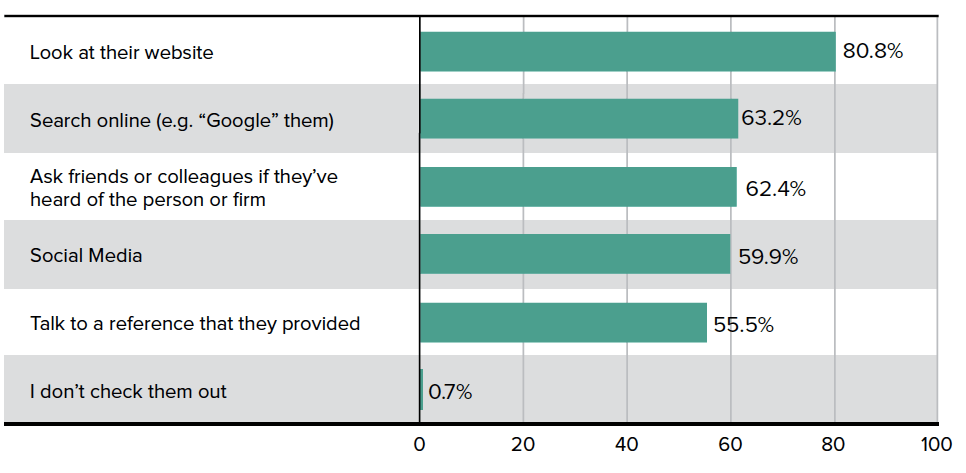“Make us more visible!” It is the mandate often heard by marketing teams for professional services firms. That is because visibility is the key to referrals and new business.
Many marketing teams are already blazing a path toward visibility for their firm using thought leadership marketing techniques, such as blog posts, books, speaking engagements or social media. But thought leadership is only one side of the equation. Metrics are the other.
A marketing team armed with the right metrics can set (and meet) expectations for visibility, can prove progress toward a particular goal, and can make educated, strategic adjustments to a marketing program as it evolves.
But which metrics matter?
Before I get into specific metrics, let me touch on four elements common to all useful metrics:
- Continuity. The metrics you track should be continually available. Being able to draw meaningful conclusions from metrics depends on your ability to analyze trends. If you can only track metrics once in a great while or inconsistently your trend analysis may be worthless.
- Objectivity. When it comes to metrics think objectivity. Subjective metrics are waste of time because you and your marketing team will second-guess each result and interpretation. For example, the number of “qualified leads” is a good metric to track. But, unless you have a narrow and well understood definition for qualified leads, different members of your marketing team could interpret a the same data differently. The metric then becomes a source of lengthy debate rather than a source for educated improvement. So stick to objective metrics.
The metrics you select should be relevant to both the marketing team and your firm’s leadership. For example, if you’re a federal government contractor you are less interested in email open rates than a firm working within the commercial space. That is because the government enforces strict email filters. An open rate would not give you a realistic understanding of your visibility. - Ability to monitor. Finally, select metrics that are easy to monitor. Metrics that requires you to jump through hoops just aren’t sustainable, and will quickly fall by the wayside. Better not to waste your time in the first place.
Now that we’ve explored the common elements that make a good metric, let’s explore the three metric categories that really matter.
There are really three important categories of metrics to focus on: visibility metrics, reputation metrics, and expertise-related metrics.
Metrics Category #1—Visibility
 It may be obvious, but visibility metrics help you assess how visible your firm and its team of experts are in the marketplace.
It may be obvious, but visibility metrics help you assess how visible your firm and its team of experts are in the marketplace.
1) Website traffic. Perhaps the single best visibility metric is the traffic to your website. We learned from our research that the website is one of the more visible pieces of any professional services brands. Research also confirmed our hypothesis that the vast majority of people you connect with—not just prospects, but influencers and potential recruits, as well—will check out your website to get a better sense of what you do and for whom.
Having said that, it’s important to note that every website draws different types of traffic:

- Direct traffic refers to people who type your URL directly into a browser or follow a link to your website from another source.
- Organic traffic, on the other hand, refers to someone who uses Google (or another search engine) to search for a term or a concept and finds your website in the results.
- Referral traffic reflects traffic from other websites that link back to yours.
- Social media traffic is, of course, traffic that comes to you from other social media sites. Regularly tracking this social media can help you make strategic decisions about which sites to have an active presence or where to run paid campaigns.
Knowing the specifics for each type of web traffic can allow you and your marketing team to make adjustments to your SEO strategy or your social media channel strategy near real time. If you are a guest blogger, for example, you can measure the efficacy of your guest blog strategy through referral traffic.
2) Social media followers. Another finding from our research is that almost 1 in 5 prospective buyers will check you out on social media before selecting you as a service provider. In fact, buyers are using social media to determine and judge just how much expertise your firm really has. So, tracking social media followers by platform (LinkedIn or Twitter followers, for example) is a powerful way to gauge the breadth of your visibility and how prospects are checking you out.

3) Email. If email campaigns are part of your broader marketing strategy, consider 4 email marketing metrics that help measure your visibility and reach:
- Email list size. Your email list size is a good indicator of visibility. That is because the more visible your firm, the bigger your list. Your marketing program should be building a list with the addresses of folks who have interacted with your firm. For example, visitors to your website come across content (blogs, white papers, etc.) and click a “download” or “subscribe” button. They are signaling they want more engagement.
- Email open rate. Do you know how many people actually open the emails you send? You should. A/B testing on email subject lines, in particular, can help you improve your open rates, so tracking them regularly will be a good indicator of anything that needs to change with your current strategy.
- Click-through rate. Your click-through rate tells you how appealing a particular email offer is by revealing the percentage of folks who were compelled to take action—namely, opening your email!
- Unsubscribe rate. Most firms have a steady unsubscribe rate. If you notice a sudden jump in your unsubscribe rate, you have a deeper, more strategic understanding of adjustments that need to be made.
SEE ALSO: 3 Huge Reasons Why You Should Care About Online Branding
Metrics Category #2—Reputation
In addition to measuring visibility, your marketing team should track indicators of your firm’s reputation for expertise and thought leadership, as well as that of the firms’ subject matter experts. This can be measured through content you publish, as well as contacts you create, such as through speaking at events, etc. Let’s take a closer look at each type.
4) Premium content downloads. Premium content is educational content that is more substantial than a blog and, therefore, more valuable (to both you and your readers). Because of its value, such content is usually gated or sitting behind a form. If someone downloads any premium content, it is a great indication of how your expertise is viewed and valued.
5) Blog traffic. Similarly, the volume of traffic to your blog is an excellent indicator of how well your expertise is being received. Outreach through guest blogging can be a great way of demonstrating expertise, as can tracking the number of guest post or articles and your earned media coverage (i.e. the mentions you get by other outlets). All are very informative metrics to track.
6) Online endorsements. Each time your thought leadership is shared through social channels, you are essentially receiving validation that someone thinks your content is good and your expertise is valid. Online endorsements can be tracked two ways: 1) Track each time your content gets shared in social media (noting which channels, as well) 2) Track any inbound links back to your site.
7) Speaking engagements. We find that marketing teams aren’t very diligent about tracking the speaking engagements of their team or experts. Our research into High Growth firms points to speaking engagements as one of the most effective techniques firms (and their experts) can use to generate leads and bring in business. Tracking the number of engagements per expert at your firm is an excellent indicator of how well your firm’s expertise is being recognized and understood.
Metrics Category #3—Expertise
The last bucket of metrics that I recommend you track religiously are those metrics that point to the effect your expertise has on your market. These, coincidentally, are the metrics most commonly tracked by marketing teams.
8) Inbound leads. Is your program attracting and nurturing leads to the middle stage of the business development funnel, where they are filling out forms or reaching out in other ways? Or are your leads falling off too early in the engagement process? Tracking form fills, phone calls and direct emails requesting a conversation are great ways to track how strong the inbound leads coming your way really are and—what results they produce.
9) Proposals out. Is your program leading prospects to requests for proposals? Monitor this conversion by tracking the number of proposals and their dollar value. Most marketing teams will track this on a weekly or monthly basis.
10) Proposal wins. Beyond the proposals, what is your win rate and how is it evolving with your marketing program? Weekly and monthly tracking of new client proposals vs existing client proposals, as well as the weekly or monthly number and cumulative dollar value are common win rate metrics.
The Effect of Metrics on Growth and Profitability
At the end of the day, marketing programs aren’t just about making your firm (and you) more visible in social channels or bringing in leads. Leadership will likely hold any marketing program accountable for overall growth and profitability. And, whereas with most of the other metrics that you will likely track weekly and monthly, you’ll likely run monthly/quarterly and annual comparison reports for growth and profitability.
Your marketing team may have unique circumstances that necessitate tracking additional metrics. But by organizing your thinking around these categories of metrics – Visibility, Reputation, and Expertise – you’ll arm yourself with the key information you need to tell enough of the ROI story to manage expectations, make future adjustments, and create a fully informed context.
Additional Resources
- For more hands-on help on increasing your firm’s visibility, register for our Visible Firm® course through Hinge University.
- Our Lead Generating Website Guide details how your firm can generate qualified leads with its website.
- Download Hinge’s Content Marketing Guide for Professional Services Firms for tips on creating content that builds credibility and demonstrates expertise.
How Hinge Can Help
Hinge has developed a comprehensive plan, the Visible Firm® to address these issues and more. It is the leading marketing program for delivering greater visibility, growth, and profits. This customized program will identify the most practical offline and online marketing tools your firm will need to gain new clients and reach new heights.


